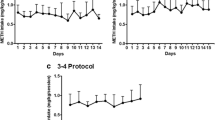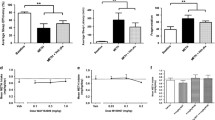Abstract
Rationale
Sleep disorders and substance abuse are highly comorbid. Although methamphetamine is a very commonly abused drug, to the best of our knowledge, no study has evaluated its effects on sleep during drug use and abstinence under well-controlled conditions in laboratory animals.
Objectives
The objective of this study was to examine the effects of methamphetamine self-administration on sleep-like measures in nonhuman primates.
Methods
Adult male rhesus monkeys (Macaca mulatta; n = 4) self-administered methamphetamine (0.01 and 0.03 mg/kg/injection, i.v.) under a fixed-ratio 20 schedule of reinforcement (60-min sessions once a day, 5 days per week) for 5 weeks. Sleep-like measures were evaluated with Actiwatch monitors before, during, and after each period of drug self-administration.
Results
Both doses of methamphetamine reliably maintained self-administration. Methamphetamine (0.03 mg/kg) increased derived measures of latency to sleep onset and sleep fragmentation, and decreased sleep efficiency compared to abstinence, and higher methamphetamine intake predicted worse sleep quality. However, sleep normalized immediately after the discontinuation of methamphetamine self-administration.
Conclusions
Methamphetamine markedly disrupted sleep-like measures; however, methamphetamine self-administration did not disrupt sleep quality during subsequent periods of drug abstinence.





Similar content being viewed by others
References
Andersen ML, Kessler E, Murnane KS, Mcclung JC, Tufik S, Howell LL (2010a) Dopamine transporter-related effects of modafinil in rhesus monkeys. Psychopharmacol 210:439–448
Andersen ML, Santos-Silva R, Bittencourt LR, Tufik S (2010b) Prevalence of erectile dysfunction complaints associated with sleep disturbances in Sao Paulo, Brazil: a population-based survey. Sleep Med 11:1019–1024
Andersen ML, Martins RCS, Matos GP, Tufik S (2010c) Effect of sleep deprivation on cocaine-induced convulsions in rats. Sleep Science 3:69–73
Andersen ML, Sawyer EK, Howell LL (2012) Influence of chronic RTI-336 treatment on behavior and hormonal levels in rhesus monkeys. Exp Clin Psychopharmacol 20:77–83
Balster RL, Schuster CR (1973) A comparison of d-amphetamine, l-amphetamine, and methamphetamine self-administration in rhesus monkeys. Pharm Biochem Behav 1:67–71
Balster RL, Kilbey MM, Ellinwood EH Jr (1976) Methamphetamine self-administration in the cat. Psychopharmacologia 46:229–233
Brecht ML, von Mayrhauser C, Anglin MD (2000) Predictors of relapse after treatment for methamphetamine use. J Psychoactive Drugs 32:211–220
Comer SD, Hart CL, Ward AS, Haney M, Foltin RW, Fischman MW (2001) Effects of repeated oral methamphetamine administration in humans. Psychopharmacology 155:397–404
Cruickshank CC, Dyer KR (2009) A review of the clinical pharmacology of methamphetamine. Addiction 104:1085–1099
Drager LF, Krieger EM, Lorenzi-Filho G (2007) Sympathetic activity, heart failure, obesity, and metabolic syndrome: is there any role for obstructive sleep apnea? Hypertension 49:e38
Freeman KB, Wang Z, Woolverton WL (2010) Self-administration of (+)-methamphetamine and (+)-pseudoephedrine, alone and combined, by rhesus monkeys. Pharmacol Biochem Behav 95:198–202
Gossop MR, Bradley BP, Brewis RK (1982) Amphetamine withdrawal and sleep disturbance. Drug Alcohol Depend 10:177–183
Hart CL, Ward AS, Haney M, Foltin RW, Fischman MW (2001) Methamphetamine self-administration by humans. Psychopharmacology (Berl) 157:75–81
Hasler BP, Smith LJ, Cousins JC, Bootzin RR (2012) Circadian rhythms, sleep, and substance abuse. Sleep Med Rev 16:67–81
Howell LL, Wilcox KM (2001) Intravenous drug self-administration in nonhuman primates. In: Buccafusco JJ (ed) Methods of behavior analysis in neuroscience. CRC, Boca Raton, pp 91–110
Karila L, Weinstein A, Aubin HJ, Benyamina A, Reynaud M, Batki SL (2010) Pharmacological approaches to methamphetamine dependence: a focused review. Br J Clin Pharmacol 69:578–592
Mann TM, Williams KE, Pearce PC, Scott EA (2005) A novel method for activity monitoring in small non-human primates. Lab Anim 39:69–77
Marshall BD, Grafstein E, Buxton JA, Qi J, Wood E, Shoveller JA, Kerr T (2012) Frequent methamphetamine injection predicts emergency department utilization among street-involved youth. Public Heath 126:47–53
McGregor C, Srisurapanont M, Jittiwutikarn J, Laobhripatr S et al (2005) The nature, time course and severity of methamphetamine withdrawal. Addiction 100:1320–1329
Murnane KS, Andersen ML, Rice KC, Howell LL (2012) Selective serotonin 2A receptor antagonism attenuates the wake-promoting and dopamine releasing effects of amphetamine.
Naidoo S, Smith D (2011) Methamphetamine abuse: a review of the literature and case report in a young male. SADJ 66:124–127
Perez AY, Kirkpatrick MG, Gunderson EW, Marrone G, Silver R, Foltin RW, Hart CL (2008) Residual effects of intranasal methamphetamine on sleep, mood, and performance. Drug Alcohol Depend 94:258–262
Roth ME, Carroll ME (2004) Sex differences in the acquisition of IV methamphetamine self-administration and subsequent maintenance under a progressive ratio schedule in rats. Psychopharmacology (Berl) 172:443–449
Srisurapanont M, Jarusuraisin N, Jittiwutikan J (1999) Amphetamine withdrawal: I. reliability, validity and factor structure of a measure. Aust NZ J Psychiatry 33:89–93
Szymanski FM, Filipiak KJ, Hrynkiewicz-Szymanska A, Grabowski M, Dabrowska-Kugacka A, Opolski G (2011) The high risk of obstructive sleep apnea—an independent risk factor of erectile dysfunction in ST-segment elevation myocardial infarction patients. J Sex Med 8:1434–1438
Terrill PI, Mason DG, Wilson SJ (2010) Development of a continuous multisite accelerometry system for studying movements during sleep. Conf Proc IEEE Eng Med Biol Soc 2010:6150–6153
Van Cauter E, Spiegel K, Tasali E, Leproult R (2008) Metabolic consequences of sleep and sleep loss. Sleep Med 9:S23–S28
Wang Z, Woolverton WL (2007) Estimating the relative reinforcing strength of (+/-)-3,4-methylenedioxymethamphetamine (MDMA) and its isomers in rhesus monkeys: comparison to (+)-methamphetamine. Psychopharmacology (Berl) 189:483–488
Woolverton WL, Cervo L, Johanson CE (1984) Effects of repeated methamphetamine administration on methamphetamine self-administration in rhesus monkeys. Pharmacol Biochem Behav 21:737–741
Yokel RA, Pickens R (1973) Self-administration of optical isomers of amphetamine and methylamphetamine by rats. J Pharmacol Exp Ther 187:27–33
Zanini GAV, Tufik S, Andersen ML, Martins RCS, Bueno OFA, Rodrigues CC, Pompeia S (2012) Free recall of word lists under total sleep deprivation and after recovery sleep. Sleep 35:223–230
Acknowledgments
The authors express their gratitude to Lisa Neidert, Juliet Brown, and Mi Zhou for their excellent assistance with the experiments and Eileen Kessler Sawyer who gave helpful comments on the manuscript. This research was supported by USPHS Grants DA10344 (LLH), DA31246 (LLH), and P51OD11132 (Yerkes National Primate Research Center) and by AFIP and CNPq (MLA).
Conflict of interest
The authors declared no conflict of interest.
Author information
Authors and Affiliations
Corresponding author
Rights and permissions
About this article
Cite this article
Andersen, M.L., Diaz, M.P., Murnane, K.S. et al. Effects of methamphetamine self-administration on actigraphy-based sleep parameters in rhesus monkeys. Psychopharmacology 227, 101–107 (2013). https://doi.org/10.1007/s00213-012-2943-2
Received:
Accepted:
Published:
Issue Date:
DOI: https://doi.org/10.1007/s00213-012-2943-2




